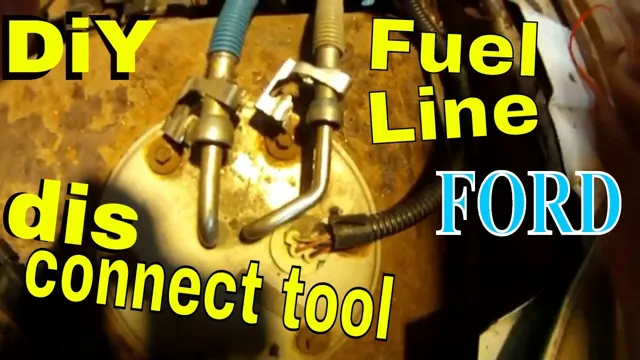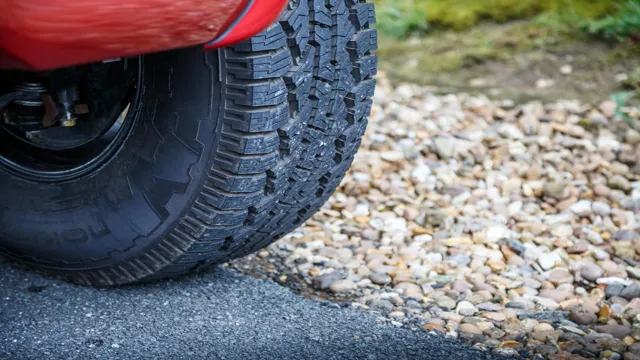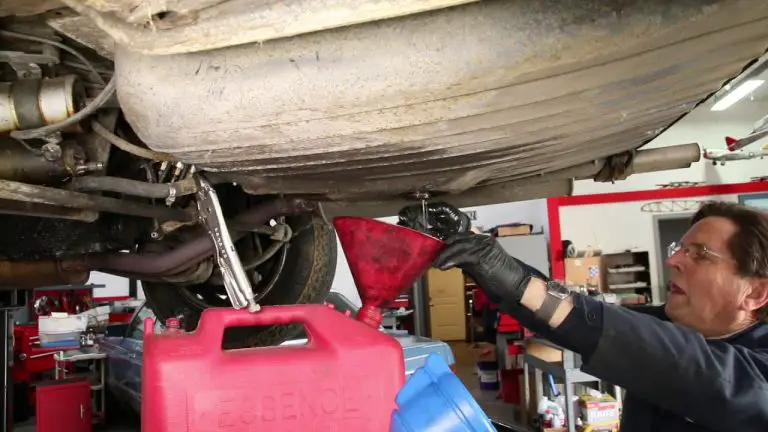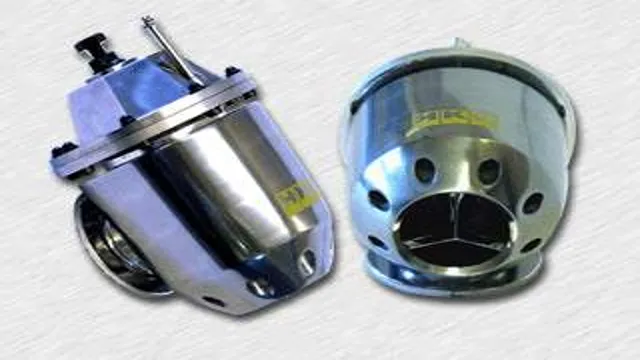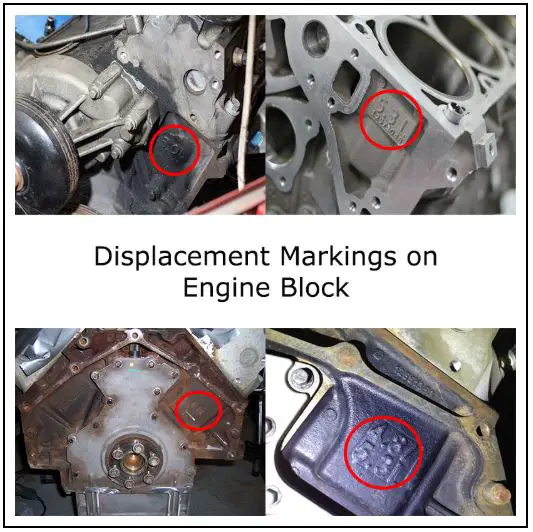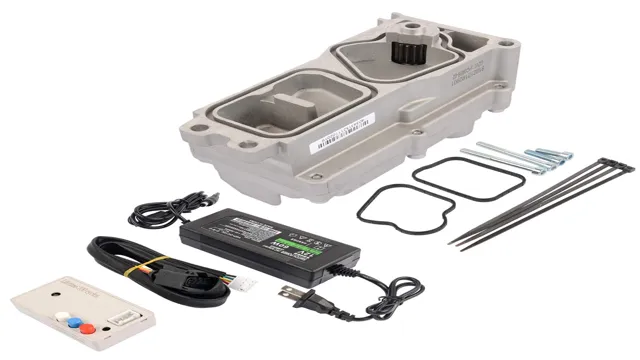Fuel Pump Hack: Learn how to safely and easily disconnect fuel pump lines in 3 easy steps!
Picture this scenario: You’re working on your car, and you need to replace the fuel pump. However, there’s one thing standing in your way – the fuel pump lines. Disconnecting these lines can be a daunting task, especially if you’re inexperienced or unsure of what you’re doing.
Fortunately, we’re here to provide you with a step-by-step guide that will make the process much easier. Whether you’re a seasoned car enthusiast or a beginner, our guide will help you disconnect fuel pump lines with ease. So grab your tools and get ready to learn!
Prepare Your Work Area
When it comes to disconnecting fuel pump lines, it’s important to prepare your work area properly. This means finding a level surface to work on, making sure you have all the necessary tools on hand, and wearing appropriate safety gear. Before starting the process, it’s best to consult your vehicle’s owner manual to locate the fuel pump and learn how to disconnect the lines safely.
Once you’ve found the pump, you can begin disconnecting the lines by removing any clamps or fittings that are holding them in place. It’s important to use caution throughout this process since fuel can be highly flammable and dangerous if not handled properly. Make sure to follow all safety precautions and take your time to ensure you disconnect the lines correctly.
Overall, with the right tools and knowledge, disconnecting fuel pump lines can be a relatively simple task that is well within reach for many car owners.
Park your vehicle in a well-ventilated area with good lighting.
Preparing your work area is an essential aspect of vehicle maintenance. Before you get started, make sure that you park your vehicle in a well-ventilated area with good lighting. This will help you see what you’re doing and ensure that you can work safely and efficiently.
Whether you’re changing your oil, replacing your brake pads, or working on any other aspect of your vehicle, having a workspace that is free from distractions and well-lit is crucial for getting the job done right. Additionally, it’s important to have access to all the necessary tools and equipment you’ll need before you start your work. Having a clear and organized workspace will save you time and keep you from getting frustrated when you’re in the middle of a repair.
Remember that a well-prepared workspace is essential to getting the job done right and keeping your vehicle in tip-top shape.
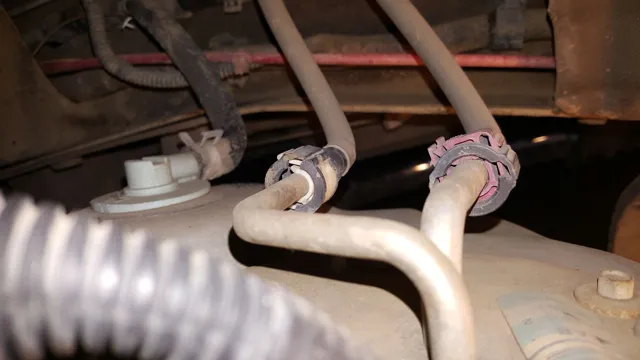
Make sure the engine is cool and the ignition is off to avoid sparks.
When it comes to working on your car, safety should always come first. Before you begin, make sure that the engine is cool and the ignition is off to avoid the risk of sparks. It is also important to take the appropriate precautions when preparing your work area.
This means finding a flat and level surface, ideally in a well-ventilated area that is free from clutter and obstacles. You should also wear appropriate safety gear, such as gloves and eye protection, to prevent injury during the job. By taking these simple steps, you can ensure that you are able to work on your car safely and effectively, without putting yourself or anyone else at risk of harm.
Remember, a little caution now can go a long way in preventing potential damage or injuries later on. So, take the time to prepare your work area properly and stay safe as you tackle your car maintenance tasks.
Identify the Fuel Pump
If you’re looking to disconnect your fuel pump lines, the first step is to identify where the fuel pump is located in your vehicle. It’s typically located near the gas tank or in the engine compartment. Once you’ve located the fuel pump, you’ll want to disconnect the fuel lines that are connected to it.
These lines can normally be disconnected using a fuel line disconnect tool. Simply insert the tool into the fuel line, then release the locking tabs to disconnect the line. It’s important to note that fuel lines will still have some fuel in them, so it’s important to use caution and wear gloves when disconnecting them to prevent any fuel from coming into contact with your skin.
By identifying the fuel pump and using the proper tools, disconnecting fuel pump lines can be done safely and easily.
Consult your vehicle’s manual to locate the fuel pump and related lines.
To identify the fuel pump in your vehicle, the first step is to consult your owner’s manual. The fuel pump is typically located inside the fuel tank, and in some vehicles, it may be accessed through a panel beneath the back seat or trunk. Once you have located the fuel pump, examine the fuel lines leading to and from it.
These lines are responsible for delivering fuel to the engine and returning excess fuel to the tank. It’s essential to identify any wear or damage to the fuel lines as they can cause leaks or restrict fuel flow to the engine, resulting in poor performance. Additionally, check the wiring and electrical connections for the fuel pump.
Corrosion, loose connections, or damaged wires can cause the fuel pump to malfunction, leading to engine stalls or failure to start. By identifying the fuel pump and related components, you can diagnose fuel system issues and perform necessary maintenance or repairs to ensure optimal performance of your vehicle.
Wear safety goggles and gloves to protect yourself from fuel splashes.
When it comes to fueling up your vehicle, it’s important to identify the fuel pump at the gas station. The fuel pump is usually located outside near the gas station canopy, and can typically be identified by the overhead sign displaying the price of gas. It’s important to wear safety goggles and gloves when fueling up to protect yourself from any accidental fuel splashes.
Once you’ve found the pump, make sure to select the grade of gasoline you need for your vehicle, and insert your payment method. Some pumps may require you to enter your zip code or swipe a loyalty card before you can begin fueling up. Once you’ve started pumping, make sure to stand close to the pump and avoid any distractions, like using your phone, to prevent accidents.
By following these simple steps and taking necessary safety precautions, you can easily fuel up at the gas station without any issues or mishaps.
Relieve Fuel System Pressure
If you need to disconnect your fuel pump lines, the first step you should always take is to relieve the fuel system pressure. This is an important safety measure, as fuel can be incredibly dangerous if it’s not handled properly. To do this, you’ll need to locate the fuel pump relay or fuse and remove it.
This will prevent the fuel pump from running and remove the pressure from the fuel lines. Then, start the engine and let it run until it stalls. This should only take a few seconds.
Once the engine has stopped, turn off the ignition and reconnect the fuel pump relay or fuse. Now, you can safely disconnect the fuel lines without worrying about fuel spraying out and causing damage or injury. Remember to take your time and follow these steps carefully to ensure your safety and the safety of others.
Use a pressure gauge or a bleed valve to remove fuel pressure from the lines.
Relieving fuel system pressure is an essential step before working on any fuel-related components. It helps prevent any fuel spills or injury. The most common ways to relieve fuel pressure are using a pressure gauge or a bleed valve.
A pressure gauge measures the pressure in the fuel system by connecting it to a fitting on the fuel rail. Then, the valve on the gauge is opened to release the pressure. On the other hand, a bleed valve is typically located near the fuel filter or pump.
It can be opened to release the pressure by allowing a small amount of fuel to escape. When working with the fuel system, you should also wear eye protection and gloves to avoid any fuel coming into contact with your skin or eyes. The process of relieving fuel pressure can be dangerous if not followed correctly, so take your time and be cautious to ensure your safety.
Remember, always be careful when dealing with high-pressure fuel systems.
This prevents fuel leaks and explosions when disconnecting the pump.
Relieving fuel system pressure is an important step that should not be overlooked when disconnecting the fuel pump. It involves removing the fuel pressure from the system to prevent fuel leaks and explosions. To relieve the pressure, one should start by locating the fuel pump fuse or relay and unplugging it.
This will allow the engine to continue running until all the fuel in the lines has been used up. Once the engine shuts off, one can disengage the fuel pump safely. Picture this: you are at home, disconnecting your fuel pump to replace it.
You forgot to relieve the fuel system pressure, and as soon as you disconnect the pump, fuel sprays out of the lines, creating a dangerous fire hazard. This is exactly why fuel system pressure relief is important. It can prevent such accidents and ensure your safety.
Remember, taking the extra time to relieve the fuel system pressure is worth the effort in the long run. It is an easy step that anyone can perform, and it doesn’t require any special tools or equipment. So, before you disconnect any fuel pump, take a few moments to relieve the fuel system pressure and ensure a safe and smooth repair.
Disconnect the Fuel Pump
Are you in the process of replacing your fuel pump and feeling overwhelmed with all the steps? One important step is disconnecting the fuel pump lines. To do this, you must first locate the fuel pump relay or fuse, and then disconnect them to ensure that pressure is relieved in the system. Once the pressure is relieved, detach the fuel lines from the fuel pump using a quick disconnect tool.
This tool is designed to easily disconnect the fuel lines without causing any damage to the pump or the lines. It’s important to note that when disconnecting the fuel pump lines, you need to take some safety precautions. For instance, wear protective gloves and goggles to avoid exposure to fuel.
Also, ensure that there are no open flames or sparks nearby, as fuel is highly flammable and can easily catch fire. With a quick disconnect tool, the process of disconnecting fuel pump lines becomes a breeze. You can then proceed to replace the fuel pump or perform any necessary repairs without any further issues.
With these tips, you can safely and efficiently disconnect fuel pump lines and ensure your vehicle runs smoothly.
Locate the fuel pump and its inlet and outlet lines, and disconnect them from the pump.
When it comes to disconnecting the fuel pump, you first need to locate it and its inlet and outlet lines. The fuel pump is responsible for delivering fuel to the engine, so it’s a crucial component of your vehicle’s performance. To disconnect it, you’ll need to locate it underneath the car and remove any protective coverings.
Once you’ve located it, you’ll need to carefully disconnect the inlet and outlet lines, taking care not to damage them in the process. You may need to use pliers or a wrench to loosen any fittings, but be sure to do so gently to avoid any leaks or damage to the fuel system. Once the lines are disconnected, you can remove the fuel pump from its housing and move on to the next step in your repair or maintenance project.
Remember, it’s important to work carefully and methodically to avoid any accidents or damage to your vehicle.
Use a flare nut wrench or a fuel line disconnect tool to loosen the fittings.
Disconnecting the fuel pump requires the use of either a flare nut wrench or a fuel line disconnect tool to loosen the fittings. When performing this task, it’s important to ensure that the engine is completely turned off and the fuel lines are depressurized. Otherwise, the fuel pump may still contain pressurized fuel and could cause potential danger.
Once you have identified the fuel pump and protective cover that surrounds it, use the appropriate tool to gently loosen the fittings. It’s important to avoid too much force as it could damage the fittings and cause leaks. Once the fittings are loosened, gently remove the fuel lines and store them in a clean, dry location.
It’s important to handle the fuel lines and fittings with care as fuel can be volatile and combustible. Disconnecting the fuel pump requires accuracy and attention to detail to avoid damaging the vehicle and ensure a proper connection when the pump needs to be replaced. Therefore, always consult a professional if you’re unsure how to disconnect the fuel pump safely and effectively.
Be gentle with the lines and fittings to avoid damage and leaks.
When it comes to disconnecting the fuel pump from your car, there are a few important things to keep in mind. First and foremost, be gentle with the lines and fittings to avoid damaging them, which could result in leaks and potentially dangerous situations. It’s also important to make sure the area around the fuel pump is clean and free of debris, as any dirt or grit could cause problems down the line.
To disconnect the fuel pump, you’ll need to locate it within your car’s engine or fuel system. This may require consulting your owner’s manual or doing some research online to ensure you know what to look for. Once you’ve located the pump, you’ll need to carefully remove any lines or fittings that are connecting it to the rest of the system.
Throughout the process, it’s important to pay close attention to what you’re doing and to avoid rushing. Taking your time will ensure that you don’t miss anything important and that you’re able to disconnect the fuel pump safely and without incident. By being gentle, thorough, and careful, you can keep your car’s fuel system running smoothly and avoid any potential problems down the line.
Inspect and Replace Parts
If you need to replace your fuel pump or inspect parts of your fuel system, it’s important to know how to disconnect fuel pump lines properly. First and foremost, it’s critical to ensure that the engine is cool and that there is no fuel pressure in the system. You’ll also want to have a drain pan handy to catch any fuel that may leak out during the process.
To disconnect the pump lines, locate the fuel pump and locate the fuel line that runs to the engine. Use a line wrench to loosen the fittings on the line and carefully slide the line off of the pump. Be sure to have a rag or towel ready to catch any fuel that may spill out.
Repeat this process for all of the fuel lines connected to the pump. Keep in mind that fuel lines can be delicate, so it’s important to handle them with care to avoid damaging them. With the lines disconnected, you can now inspect or replace the fuel pump or other parts of the fuel system as needed.
By following these steps, you can safely and effectively disconnect your fuel pump lines and keep your vehicle running smoothly.
Check the fuel pump, lines, and fittings for wear, damage, or contamination.
When it comes to ensuring your car is running smoothly, one crucial component to keep an eye on is the fuel pump. Over time, fuel pumps, lines, and fittings can wear out, become damaged, or even be contaminated, causing problems with your car’s performance. To avoid running into any issues, it’s essential to inspect these parts regularly and replace them if necessary.
Neglecting to do so could result in decreased fuel efficiency, poor acceleration, and even engine failure. Think of it like keeping the pipes in your home maintained to prevent leaks and damage – maintaining your fuel pump, lines, and fittings is just as crucial. By regularly checking these parts and replacing them as needed, you can save yourself time and money in the long run while ensuring your car runs as smoothly and efficiently as possible.
Replace any faulty or worn parts with compatible ones to ensure proper fuel delivery.
If you’re experiencing issues with your vehicle’s fuel delivery, it’s essential to inspect the system’s individual components to determine the root cause of the problem. If you notice any worn or faulty parts, you should replace them immediately with compatible replacements. Common parts that may need replacing include fuel injectors, fuel pumps, and fuel filters.
These components can wear out over time or become clogged with debris, leading to poor fuel delivery and reduced engine performance. Replacing these parts with compatible options is crucial as using incompatible parts can further damage the system and potentially harm your vehicle. Therefore, it’s best to consult with a professional mechanic who can help you determine the appropriate replacements for your vehicle and ensure that they’re installed correctly.
So the next time you’re experiencing fuel delivery issues, make sure to inspect and replace any worn or faulty parts to get your vehicle back in top shape.
Reconnect the Fuel Pump
If you’re wondering how to disconnect fuel pump lines, it’s important to note that you’ll need to reconnect them properly to ensure your vehicle runs smoothly. The fuel pump is responsible for delivering fuel from the gas tank to the engine, so it’s essential that it’s connected correctly. To reconnect the fuel pump, first, you’ll need to remove the old fuel pump and connect the new pump with the lines.
It’s crucial to make sure the lines are attached tightly and securely to prevent leaks. Once you’re sure everything is connected properly, you can test the fuel pump to make sure it’s working correctly before starting your vehicle. Remember to take your time and be careful when working with fuel pump lines to avoid any accidents or damage to your vehicle.
Clean the fittings and apply a small amount of lubricant or sealant to them.
After cleaning the fittings and applying some sealant or lubricant, it’s time to reconnect the fuel pump. This step is crucial for ensuring your car runs smoothly and doesn’t have any fuel-related problems. Before you reconnect the pump, make sure you double-check that everything is clean and dry.
Any leftover debris or moisture can cause issues down the line. Once you’re confident everything is ready, it’s time to reconnect the pump. Tighten all the fittings carefully and ensure that everything is secure.
The last thing you want is for fuel to leak out and cause damage to your vehicle. With the pump reconnected, turn your car on and listen for any unusual noises. If everything sounds good, you’re ready to hit the road! Remember to check on your fuel pump every few months to ensure that it’s still in good condition.
By doing this, you’ll be able to catch any issues early and avoid costly repairs.
Reconnect the fuel lines to the fuel pump and tighten the fittings securely.
When it comes to installing or replacing a fuel pump, reconnecting the fuel lines is a crucial part of the process. To reconnect the fuel lines, you will need to locate the fuel pump in your vehicle and identify the fuel lines. Typically, you will need to insert the fuel lines into the corresponding fittings on the fuel pump and secure them tightly.
It’s important to ensure that the fittings are tightened securely, as any loose connections can cause fuel leaks and potential safety hazards. Take the time to double-check all connections to make sure everything is properly secured. The last thing you want is to have to repeat the process because of a simple mistake.
With the fuel lines reconnected and secured, the fuel pump is ready to do its job and deliver the fuel your engine needs to run smoothly. So whether you are replacing a faulty fuel pump or just performing routine maintenance, always pay close attention when connecting the fuel lines to ensure a safe and reliable ride.
Test for Fuel Leaks
When it comes to testing for fuel leaks in your vehicle, one of the key steps is disconnecting the fuel pump lines. But how do you do it properly? It’s important to note that fuel lines can be under high pressure, so you’ll need to take extreme caution. First, locate the fuel pump and identify the fuel lines.
Using a fuel line disconnect tool, gently press the tool against the fuel line and push it in firmly. You may hear a click sound, indicating that the tool is locked in place. Next, gently pull the fuel line away from the fuel pump.
Be prepared for some fuel to leak out, so have a container ready to catch it. Repeat the process for the other fuel line if required. Remember to also exercise caution with the fuel you’ve collected; store it in a safe place away from ignition sources.
Overall, it’s essential to disconnect fuel pump lines carefully to avoid any potential hazards and ensure your safety.
Turn on the ignition and check for fuel leaks or abnormal sounds or smells.
Before you take that first drive in your newly repaired car, it’s important to test for any fuel leaks, abnormal sounds, or smells. This will prevent any potential accidents and ensure that your car is in good condition. To start this process, turn on the ignition without starting the engine.
This will help to pressurize the fuel system, allowing you to easily identify any fuel leaks. Look around the fuel lines, fuel filter, and fuel injector seals for any signs of a fuel leak. The last thing you want is to be driving down the road and the fuel line bursts, leaving you stranded with a damaged car.
If you detect any fuel leaks, it’s important to address them immediately and have them repaired. Ignoring a fuel leak can cause major safety hazards, not to mention it will damage your car. Additionally, while the ignition is on, listen for any abnormal sounds.
If you hear any strange noises like grinding, whining, or rattling, this could be indicative of a potential issue and require a mechanic’s attention. Lastly, pay attention to any smells; if you notice a strong odor of gas or oil, this could mean that there’s a leak or some other issue. Testing for fuel leaks, abnormal sounds, and smells doesn’t take much time, but it can prevent you from encountering bigger problems in the future.
It’s better to address any issues quickly and avoid potentially dangerous situations in the long run. So, take the time to test your car before getting behind the wheel, and avoid any unpleasant surprises.
If there are no issues, start the engine and confirm proper fuel pressure and flow.
When it comes to starting your engine, testing for fuel leaks is an essential step. Before starting the engine, check all fuel connections and ensure that there are no signs of leaks. One way to do this is to pressurize the fuel system and monitor for any drop in pressure over time.
If the pressure drops, it could be an indication of a fuel leak somewhere in the system. If there are no issues, it’s time to start the engine. However, it’s important to confirm proper fuel pressure and flow before taking off.
This ensures that the engine has enough fuel to run properly and avoids any damage that could occur from running on low fuel pressure. To test for proper fuel pressure, attach a fuel pressure gauge to the fuel rail or fuel line and start the engine. The pressure should be within the manufacturer’s recommended range.
If it’s not, it could be an indication of a fuel pump or regulator issue, and further diagnosis is needed. To check for proper fuel flow, place a container under the fuel line to catch fuel as it flows out. Then, turn the key to the “on” position but don’t start the engine.
This will activate the fuel pump and allow fuel to flow through the lines. You should see a steady stream of fuel coming out. If it’s not flowing steadily or not at all, there could be a clog or blockage in the fuel line.
Testing for fuel leaks and confirming proper fuel pressure and flow are critical steps before starting the engine. It ensures that your engine is running at its best and avoids any potential damage or issues that could arise from a faulty fuel system. So, take the time to properly test and check your fuel system before hitting the road.
Conclusion
In conclusion, disconnecting fuel pump lines may seem like a daunting task, but with a few simple steps, it can be a breeze. Remember to relieve the fuel pressure before starting, wear protective gear, and use the proper tools. So don’t be afraid to get your hands dirty and give it a try! Just remember, cutting the wrong cord could leave you stranded and fueled with regret.
So stay sharp and stay safe!”
Disconnecting fuel pump lines can be done safely and effectively with the right tools and knowledge.
Disconnecting fuel pump lines can seem like a daunting task for the average DIY mechanic, but with the right tools and knowledge, it can be done safely and effectively. One of the most important steps in disconnecting fuel pump lines is to test for fuel leaks before proceeding. This can be done by using a fuel pressure gauge to ensure that the fuel system is depressurized.
Then, the mechanic can visually inspect the fuel lines and connections for any signs of wear or damage. It’s also important to have a fire extinguisher nearby in case of any accidental sparks or ignition. With proper precautions in place, disconnecting fuel pump lines can be a breeze.
Just remember to take your time and always put safety first.
Always consult your vehicle’s manual and take appropriate safety precautions.
When it comes to maintaining your vehicle and keeping it running smoothly, it’s important to always consult your vehicle’s manual and take appropriate safety precautions. One essential step you should take is testing for fuel leaks. Not only can fuel leaks be dangerous, but they can also be costly if left unaddressed.
To test for fuel leaks, you’ll need to visually inspect the fuel lines, connections, and fuel tank for any signs of leaks or damage. You should also perform a pressure test to ensure that the fuel system is maintaining the correct pressure. By regularly testing for fuel leaks, you can catch any potential issues before they turn into larger, more costly problems.
So, be sure to prioritize this important step in your vehicle maintenance routine to keep you and your vehicle safe on the road.
FAQs
Why would I need to disconnect fuel pump lines?
There are several reasons why you might need to disconnect fuel pump lines, including performing maintenance on the fuel system or replacing the fuel pump.
What tools do I need to disconnect fuel pump lines?
You will typically need a fuel line disconnect tool, which can be found at most automotive supply stores.
Can I disconnect fuel pump lines without using a disconnect tool?
It is not recommended to disconnect fuel pump lines without using a disconnect tool, as this can damage the fuel line or the fuel pump.
How do I use a fuel line disconnect tool?
To use a fuel line disconnect tool, simply slide the tool over the fuel line until it clicks into place, then twist or pull the tool to disconnect the line from the fuel pump.

